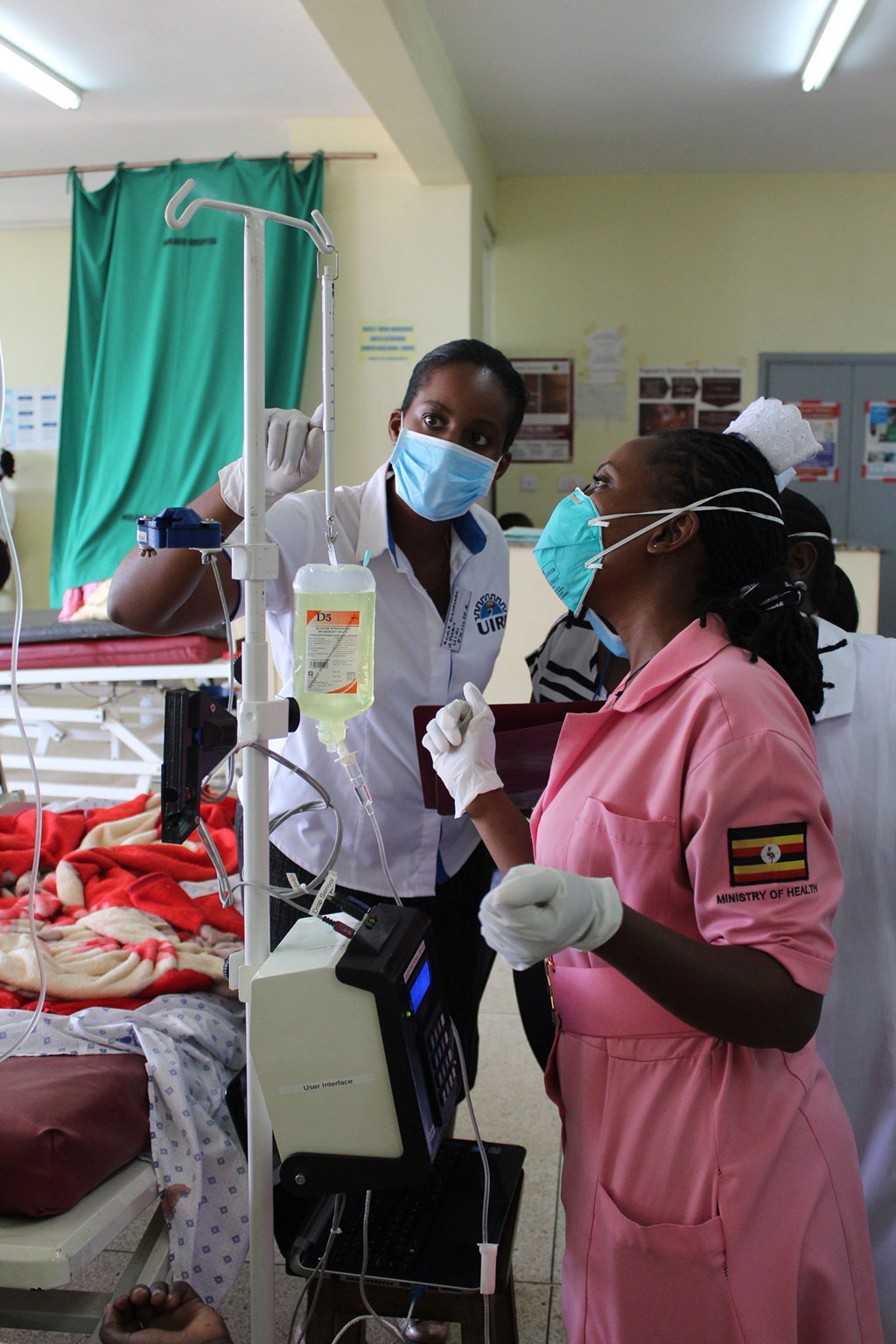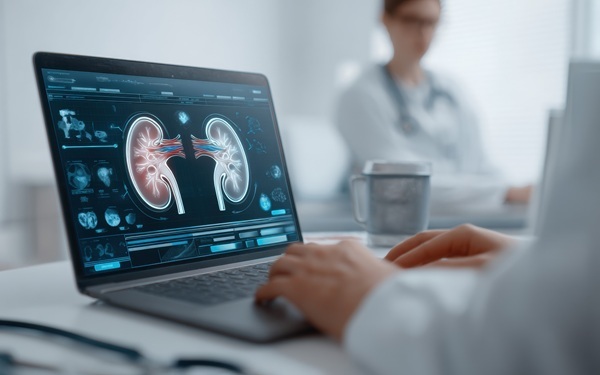Electronically Controlled Infusion System Reduces Mortality
|
By HospiMedica International staff writers Posted on 22 Sep 2020 |

Image: Nurse Winnie Kibirige sets up the ECGF-IS at Kiruddu Hospital in Kampala (Photo courtesy of UIRI)
An electronically controlled gravity-feed infusion set (ECGF-IS) can reduce mortality associated with intravenous (IV) infusions in developing countries.
The ECGF-IS, under development at Fraunhofer-Gesellschaft (Munich, Germany) institute, in collaboration with the Uganda Industrial Research Institute (UIRI; Kampala), is designed to close the gap between uncontrolled gravity-feed IV infusion and the highly precise, but extremely expensive, infusion pumps used in industrialized countries. The new system includes a drip sensor that automatically counts the number of drops of IV fluid. The roller clamp--normally found in IV sets--has been replaced by an actuator that blocks the infusion tube so that the device only administers the number of drops that are actually required to treat the patient.
The battery-powered ECGF-IS device also ensures the drip rate remains constant, while allowing it to be readjusted where necessary. A major advantage is the fact that hospitals can simply attach the new drip sensor system to their existing IV bags and tubes and continue using them. The physician can adjust all the settings via the display screen. Two clinical studies examining the safety and effectiveness of the device demonstrated a significantly more accurate flow rate than a conventional IV set used to treat a control group. A solar-powered charging station is under development for use in rural areas.
“Infusion pumps are complex to operate and costly to maintain. With spare parts often hard to obtain, they are of limited use for clinical settings in Uganda, which can sometimes be very far from ideal,” said engineer Tobias Behr, of Fraunhofer-Gesellschaft. “They are also poorly equipped to deal with varying power outages and cannot be used in areas that have no access to electricity. The results of the two studies were so promising that we’re already working on an optimization of the prototype.”
Gravity-feed infusion works by delivering fluid containing minerals, nutrients, and medications from an elevated IV bag to the patient, unlike infusion pumps that allow for much more accurate dosing of the therapeutic agent because they continuously regulate flow rate. This is not possible with gravity-feed infusion sets, which require manual adjustment using a roller clamp on the tube below the IV bag. This is often neglected due to insufficient staff. In the worst case scenario, incorrect dosing can be fatal for the patient.
Related Links:
Fraunhofer-Gesellschaft
Uganda Industrial Research Institute
The ECGF-IS, under development at Fraunhofer-Gesellschaft (Munich, Germany) institute, in collaboration with the Uganda Industrial Research Institute (UIRI; Kampala), is designed to close the gap between uncontrolled gravity-feed IV infusion and the highly precise, but extremely expensive, infusion pumps used in industrialized countries. The new system includes a drip sensor that automatically counts the number of drops of IV fluid. The roller clamp--normally found in IV sets--has been replaced by an actuator that blocks the infusion tube so that the device only administers the number of drops that are actually required to treat the patient.
The battery-powered ECGF-IS device also ensures the drip rate remains constant, while allowing it to be readjusted where necessary. A major advantage is the fact that hospitals can simply attach the new drip sensor system to their existing IV bags and tubes and continue using them. The physician can adjust all the settings via the display screen. Two clinical studies examining the safety and effectiveness of the device demonstrated a significantly more accurate flow rate than a conventional IV set used to treat a control group. A solar-powered charging station is under development for use in rural areas.
“Infusion pumps are complex to operate and costly to maintain. With spare parts often hard to obtain, they are of limited use for clinical settings in Uganda, which can sometimes be very far from ideal,” said engineer Tobias Behr, of Fraunhofer-Gesellschaft. “They are also poorly equipped to deal with varying power outages and cannot be used in areas that have no access to electricity. The results of the two studies were so promising that we’re already working on an optimization of the prototype.”
Gravity-feed infusion works by delivering fluid containing minerals, nutrients, and medications from an elevated IV bag to the patient, unlike infusion pumps that allow for much more accurate dosing of the therapeutic agent because they continuously regulate flow rate. This is not possible with gravity-feed infusion sets, which require manual adjustment using a roller clamp on the tube below the IV bag. This is often neglected due to insufficient staff. In the worst case scenario, incorrect dosing can be fatal for the patient.
Related Links:
Fraunhofer-Gesellschaft
Uganda Industrial Research Institute
Latest Critical Care News
- Nasal Drops Fight Brain Tumors Noninvasively
- AI Helps Optimize Therapy Selection and Dosing for Septic Shock
- Glowing Bacteria ‘Pills’ for Detecting Gut Diseases Could Eliminate Colonoscopies
- Skin-Permeable Polymer Patch Delivers Insulin Non-Invasively Through Skin
- Nanogel Technology Almost 100% Effective in Destroying Drug-Resistant Bacteria Within Hours
- Wearable Ultrasound Sensor Delivers Noninvasive Treatment Without Surgery
- Gel-Free ECG System to Transform Heart Health Diagnosis
- Biodegradable Patch Repairs Damaged Tissue After Heart Attack
- Magnetically Guided Microrobots to Enable Targeted Drug Delivery

- Smart Nanomaterials Detect and Treat Traumatic Brain Injuries Simultaneously
- Earlier Blood Transfusion Could Reduce Heart Failure and Arrhythmia in Heart Disease Patients
- 'Smart' Shirt Detects Epileptic Seizures in Real Time
- Skin Patch Measures Effectiveness of Flu/COVID Vaccines in 10 Minutes
- Complete Revascularization Reduces Risk of Death from Cardiovascular Causes
- Tiny Fish-Inspired Robots Navigate Through Body to Deliver Targeted Drug Therapy
- Coronary Artery Stenosis Could Protect Patients from Pulmonary Embolism Effects
Channels
Surgical Techniques
view channelNovel Endoscopy Technique Provides Access to Deep Lung Tumors
Detecting lung cancer early can save lives, but diagnosing small tumors deep in the outer regions of the lungs remains a major clinical challenge. Although CT scans frequently identify tiny suspicious... Read more
New Study Findings Could Halve Number of Stent Procedures
When a coronary artery becomes acutely blocked during a heart attack, opening it immediately is essential to prevent irreversible damage. However, many patients also have other narrowed vessels that appear... Read morePatient Care
view channel
Revolutionary Automatic IV-Line Flushing Device to Enhance Infusion Care
More than 80% of in-hospital patients receive intravenous (IV) therapy. Every dose of IV medicine delivered in a small volume (<250 mL) infusion bag should be followed by subsequent flushing to ensure... Read more
VR Training Tool Combats Contamination of Portable Medical Equipment
Healthcare-associated infections (HAIs) impact one in every 31 patients, cause nearly 100,000 deaths each year, and cost USD 28.4 billion in direct medical expenses. Notably, up to 75% of these infections... Read more
Portable Biosensor Platform to Reduce Hospital-Acquired Infections
Approximately 4 million patients in the European Union acquire healthcare-associated infections (HAIs) or nosocomial infections each year, with around 37,000 deaths directly resulting from these infections,... Read moreFirst-Of-Its-Kind Portable Germicidal Light Technology Disinfects High-Touch Clinical Surfaces in Seconds
Reducing healthcare-acquired infections (HAIs) remains a pressing issue within global healthcare systems. In the United States alone, 1.7 million patients contract HAIs annually, leading to approximately... Read moreHealth IT
view channel
EMR-Based Tool Predicts Graft Failure After Kidney Transplant
Kidney transplantation offers patients with end-stage kidney disease longer survival and better quality of life than dialysis, yet graft failure remains a major challenge. Although a successful transplant... Read more
Printable Molecule-Selective Nanoparticles Enable Mass Production of Wearable Biosensors
The future of medicine is likely to focus on the personalization of healthcare—understanding exactly what an individual requires and delivering the appropriate combination of nutrients, metabolites, and... Read moreBusiness
view channel
Philips and Masimo Partner to Advance Patient Monitoring Measurement Technologies
Royal Philips (Amsterdam, Netherlands) and Masimo (Irvine, California, USA) have renewed their multi-year strategic collaboration, combining Philips’ expertise in patient monitoring with Masimo’s noninvasive... Read more
B. Braun Acquires Digital Microsurgery Company True Digital Surgery
The high-end microsurgery market in neurosurgery, spine, and ENT is undergoing a significant transformation. Traditional analog microscopes are giving way to digital exoscopes, which provide improved visualization,... Read more
CMEF 2025 to Promote Holistic and High-Quality Development of Medical and Health Industry
The 92nd China International Medical Equipment Fair (CMEF 2025) Autumn Exhibition is scheduled to be held from September 26 to 29 at the China Import and Export Fair Complex (Canton Fair Complex) in Guangzhou.... Read more















